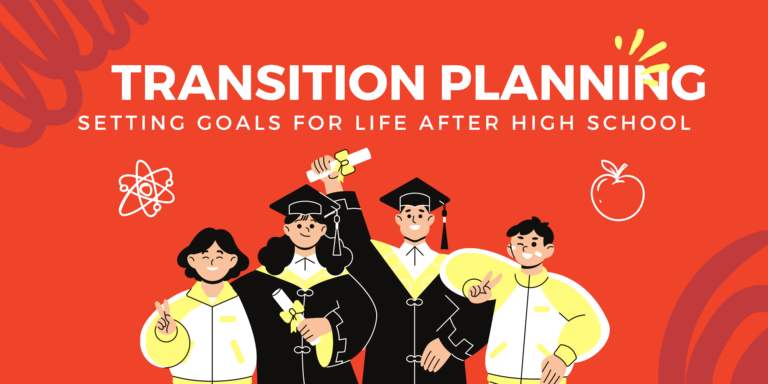
by Barb Beck
Creative Content Director, Specially Designed Education Services (SDES)
Greetings, advocates for inclusive education! Today, we embark on a crucial journey – the art of crafting post-secondary goals for students with moderate to severe disabilities. 🚀 Transition planning isn’t just a task; it’s a roadmap to a future filled with possibilities. Join us as we explore effective goal development, the power of collaboration, and the essential role of a home and school partnership. Let’s pave the way for a future where every student can shine, regardless of the challenges they may face. 💪🏽🏫
Dedicating time to transition planning early lays the foundation for a successful journey beyond school and into adulthood. For students with moderate to severe disabilities, this process should kick off in the early years. By identifying strengths, preferences, and interests, educators can tailor a roadmap that not only aligns with academic goals but also with the student’s aspirations for post-secondary life.
The heart of effective transition planning lies in well-crafted transition plans. These plans should be comprehensive, addressing vocational, educational, and functional life skills. Each goal must be specific, measurable, achievable, relevant, and time-bound (SMART). A robust transition plan becomes the guiding document, ensuring a smooth trajectory from school to post-secondary life.
Consistency is key. The development of post-secondary skills shouldn’t be confined to a specific grade or timeframe. Instead, it’s a continuous journey, with skills building upon each other. Integrating these goals into daily routines and curriculum ensures that students have ample opportunities to practice and reinforce their skills over the course of their school career.
Effective transition planning is a team effort. Bringing together educators, parents, therapists, and other stakeholders creates a powerhouse of support for the student. Regular communication, shared insights, and collaborative decision-making ensure that the transition goals remain dynamic, adapting to the student’s progress and evolving needs.
The partnership between home and school is the backbone of successful transition planning. Parents play a pivotal role in understanding and reinforcing post-secondary goals at home. Regular updates, open communication channels, and collaborative goal-setting meetings create a unified front that empowers the student both in and out of the school environment.
Cheers to Navigating Toward Graduation and Adult Life 🎓
As we navigate the realm of setting post-secondary goals for students with moderate to severe disabilities, let’s remember – every goal is a step towards a brighter future. By embracing early planning, SMART goal development, continuous skill practice, team collaboration, and a robust home-school partnership, we pave the way for inclusive post-secondary journeys where every student can thrive.
Let’s continue to champion the cause of empowering students to reach their full potential, creating a world where no goal is too ambitious, and every dream is within reach.
For more insights and resources on equipping students with effective and meaningful approaches to setting post-secondary goals, visit the Specially Designed Education Services (SDES) website at www.sdeswork.com. Feel free to reach out with any questions or to connect with experts who can guide you and your students toward effective instruction and programming. Together, let’s continue to empower students with diverse abilities, fostering a future where every educational journey is tailored for success. 🌟📚👩🏫
For more on this topic, check out the FAST 15 podcast with new episodes posting Fridays. Be sure to subscribe on your podcast platform of choice. If you like what you hear, please write a review. We’d love to hear from you!
©2023 Specially Designed Education Services
SDES has teamed up with Mundo Pato, Inc., our cloud publishing partner, to create a simple and affordable solution for special educators to use during this critical time.
The Virtual Teaching Materials are a separate supplemental purchase that will greatly enhance the Styer-Fitzgerald Program for Functional Academics or can be used on its own.
Virtual Teaching Materials Pricing 1st year: $1000 non-recurring configuration fee plus 12 x monthly charge.
Students | Per Month | Per Year* |
|---|---|---|
| 0-50 | $150 | $1800 |
| 51-75 | $225 | $2700 |
| 76-100 | $300 | $3600 |
| 101-125 | $375 | $4500 |
| 126-150 | $450 | $5400 |
| 151-175 | $525 | $6300 |
| 176-200 | $600 | $7200 |
| 201-225 | $675 | $8100 |
| 226-250 | $750 | $9000 |
| 251-275 | $825 | $9900 |
| 276-300 | $900 | $10800 |
SDES has teamed up with Mundo Pato, Inc., our cloud publishing partner, to create the full Styer-Fitzgerald Program for Functional Academics in the cloud. *The Styer-Fitzgerald Program in the Cloud Start-Up Fee: a $6000 non-recurring start-up fee will be added to the first year subscription only.
Students | Per Month | Per Year* |
|---|---|---|
| 0-100 | $500 | $6000 |
| 101-125 | $625 | $7500 |
| 126-150 | $750 | $9000 |
| 151-175 | $875 | $10500 |
| 176-200 | $1000 | $12000 |
| 201-225 | $1125 | $13500 |
| 226-250 | $1250 | $15000 |
| 251-275 | $1375 | $16500 |
| 276-300 | $1500 | $18000 |
| 301-325 | $1625 | $19500 |
| 326-350 | $1750 | $21000 |